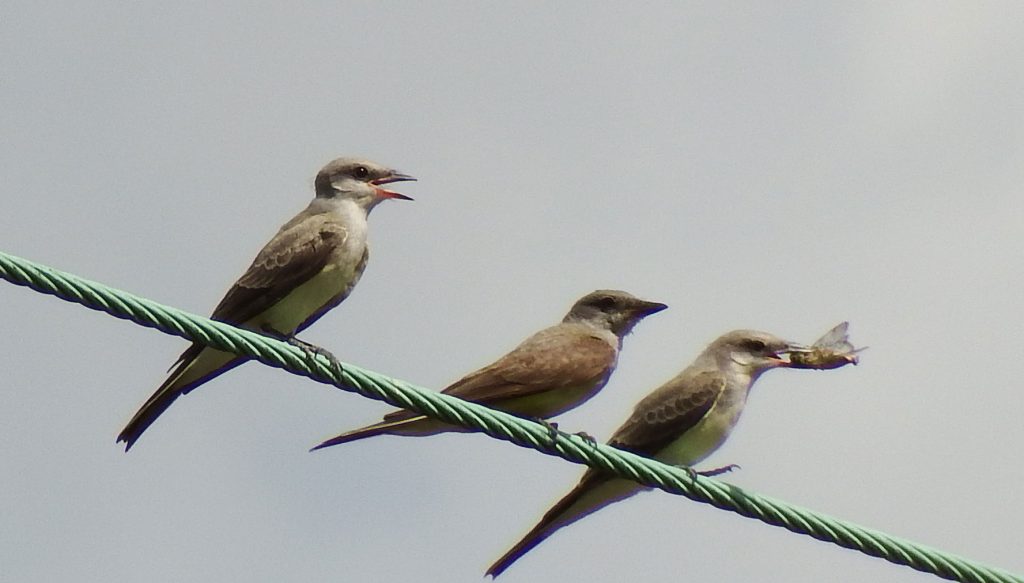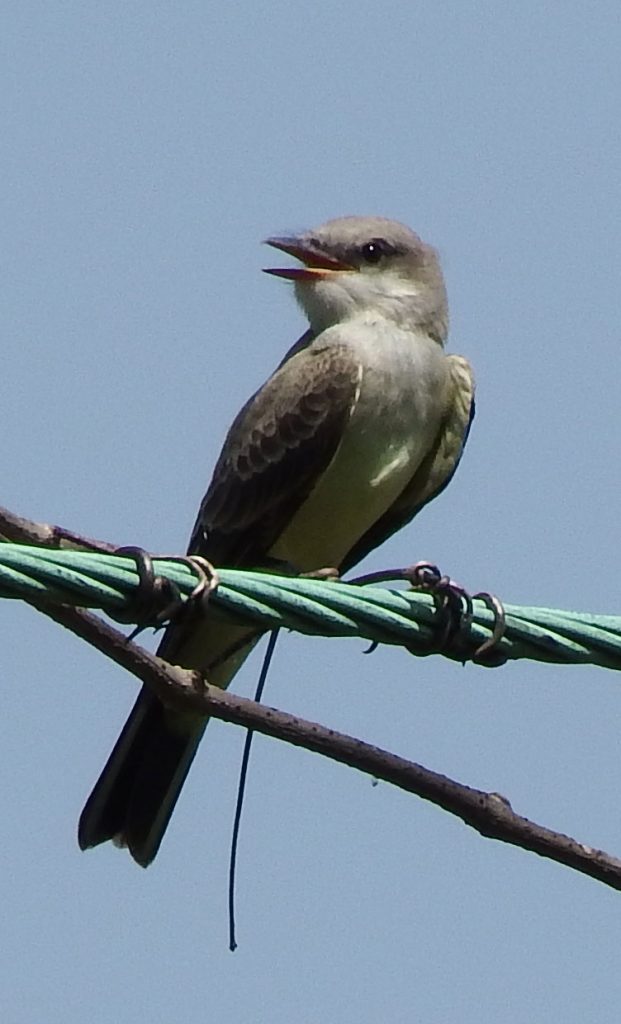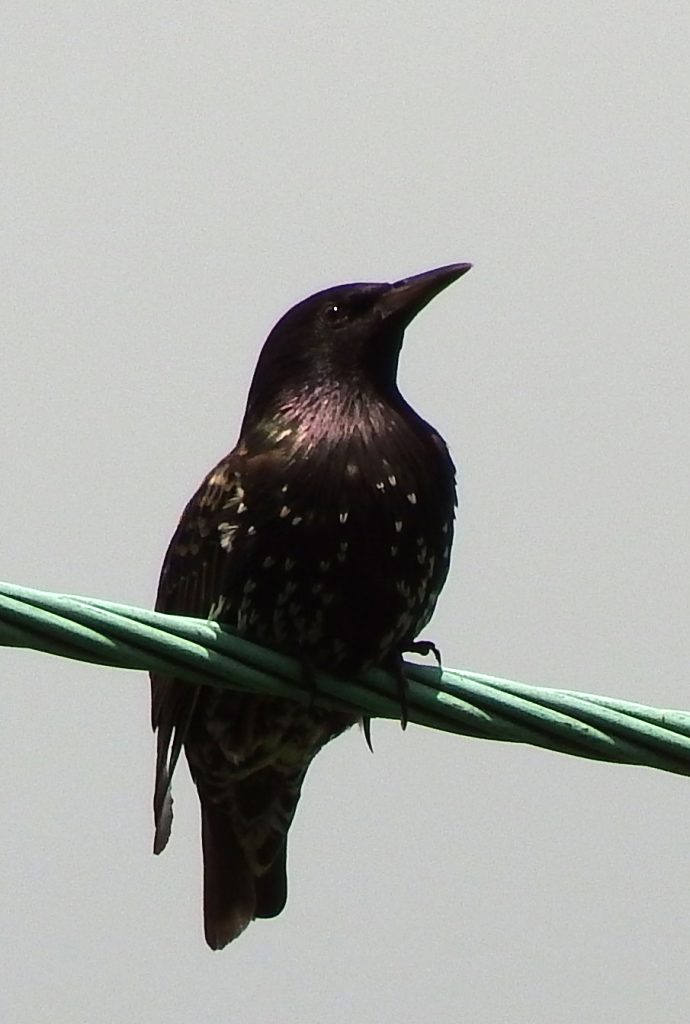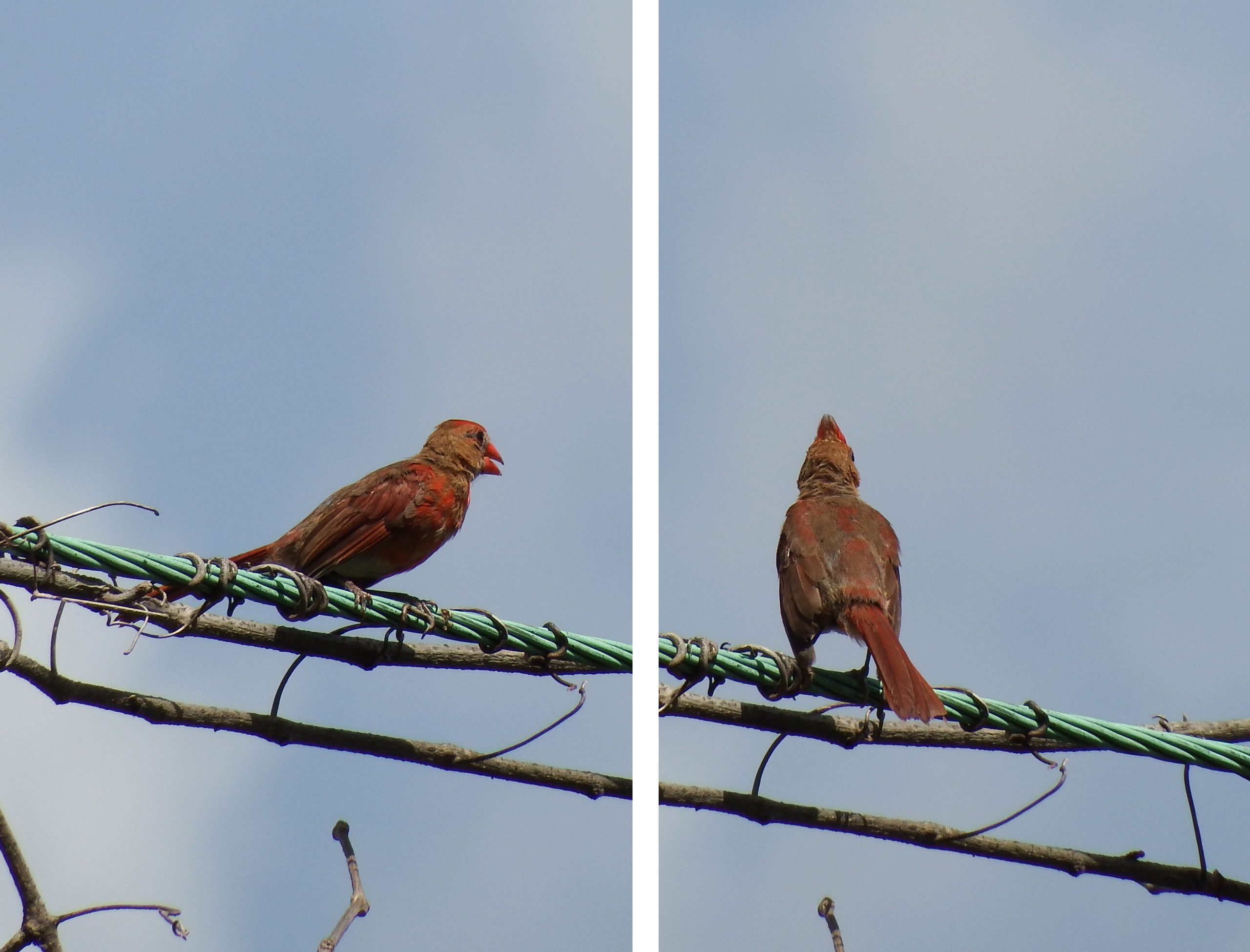A collection of unexpected

I am an enthusiastic birder and through the years, have picked up this and that. But there are always birds that simply mystify me. This week, I ran into three such birds. They were all on the high-tension power line that runs north from The Dunlavy. That tower and the line strung from it is a great place to see birds, especially those that hunt from high up. But birds on the line are rarely in good light especially on overcast days and the line itself is far off the ground, so none of the birds are close.
I have 10x binoculars, which is a slightly higher magnification than is standard (8x). But even with the added size, I was stumped by three grayish birds that didn’t look like anything I could figure. The reason this is a blog post instead of a private rant to my wife is that my camera has a lens quite a bit stronger than my field glasses. The 50x lens on my camera revealed what I had not been seeing through my binoculars.
These were western kingbirds. They are what birders call “good” birds meaning that they are birds you don’t run into every day or even every month. We don’t see them much because we are on the eastern edge of the western kingbird’s range. In their own range (which is the entire western half of the country), they are fairly common. The eastern US has the eastern kingbird, which looks very little like the western kingbird. But they are similar in shape and habits.

The pinkish color at the base of the lower bill suggests that this is a juvenile bird.
Kingbirds are flycatchers. They hunt from a high perch (perhaps a high tension wire) and fly out to nab insects winging by. Western kingbirds have been steadily expanding eastward for generations, helped in this endeavor by us. Kingbirds are not birds of the prairie. They hunt from high perches and prairies being grasslands, lack these. But the history of European establishment in the US is one of sod busting and tree planting (other ways of saying, tearing up prairies and establishing farms and woodlands). This is habitat that a western kingbird can work with.
In our own era, we have continued to help the western kingbird thrive by erecting towers to hold antennas, microwave relays and high tension wires. Another perfect perch for a western kingbird.
At least two of the birds I saw are juvenile, the ones on either end of the photo at the top of this post. You can tell by the pale pink on the lower bill. Adult bills are entirely black. Also, the bellies of these birds are barely pale yellow. Adult birds in fresh plumage have bright yellow bellies.
Here’s what happens in the video: Bird 1 (who is a juvenile based on the bottom bill color) has returned to the wire with a large and tasty insect. Said insect isn’t entirely dead yet so the kingbird beats it to death against the wire. During this activity, a chunk of the insect flies off and the other two birds leap off the wire to chase it. Watch the bird to the far left (which I suppose is now bird 3). The minute bird 1 arrived, bird 3’s beak popped open. This is a juvenile begging behavior. Gaping the mouth wide open prompts an adult bird to provide food. No one pays this bird any mind, but the gaping never entirely stops.
I think bird 2 (the middle bird) is an adult bird based on the black bill and more worn overall plumage. When the chunk falls off the insect, bird 3 is still too busy gaping to react quickly, but bird 2 is off that perch in a heartbeat.
It’s interesting that we have both juvenile and adult birds in the Park. Houston is on the very southern edge of the western kingbird’s breeding range. But the fact that we have both juveniles and adults in the Park right now means that they are probably still on their breeding ground. Western kingbirds migrate to Mexico and Central America with the adults all leaving weeks before the juveniles do. Since it’s only late July and we have both adult and juvenile birds, it suggests that they might be breeding close by. Surprising.

I had another mystery bird, but I knew what it was, I just couldn’t make much sense of it. This is a European starling. Not a “good” bird. In fact, many people hate them. In 1890, about 100 of these European birds were released into Central Park in New York. That’s all it took for the present situation where we are overrun by starlings. About 200 million of them.
But we sometimes fail to notice that they are lovely birds. A friend once rescued a blind baby and kept it as a pet for years. The bird was an amazing mimic and had a huge repertoire of music and phrases.
What is perplexing about his particular starling is that it is an adult in July and its bill is black.
You didn’t sit up and say “what!” Then let me explain.
Starlings got their name because the white spots on their iridescent black/blue/purple/green feathers look like stars in the night sky. The stars on starlings are small white tips on each feather. During the year, the feathers get worn and the edges rub off turning what had been a starry night into inky darkness. After breeding season, the starlings will molt. The old feathers will gradually fall off, replaced by new feathers with new white tips. The stars will shine again.
This bird has almost no white stars. So we know that these feathers are a year old (time for wear) and so is this bird. And we are just past breeding season. But starlings have yellow bills when they are in breeding season. It takes weeks or months for bills to turn from yellow to black. This adult bird should have a yellow bill. But he or she doesn’t. Not shocking, but surprising. Also absolutely beautiful which is why I have taken up valuable blog space talking about a not good bird like a starling.
Just as I was about to post this, I double-checked that this story about the word starling is correct. I can find other references to it but nothing definitive; it might be apocryphal.

Since this post is becoming my bird molt post, I should also include this less than lovely mid-molt male cardinal. This is what happens during a molt. Those worn out not even still really red feathers get replaced by shiny new bright-red ones. This bird is somewhere in the middle of that process. I’m pretty sure this is an adult bird going through a molt rather than a juvenile entering adult plumage. In young cardinals, the bill is not usually this orange. But there are no hard and fast rules as this blog post alone illustrates.

